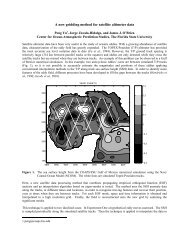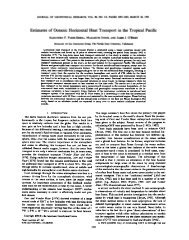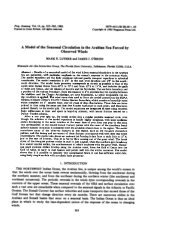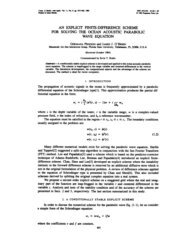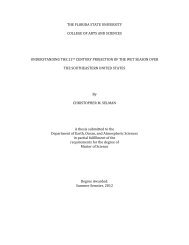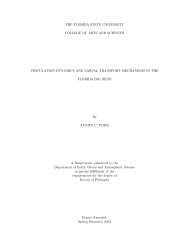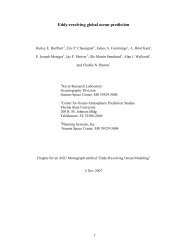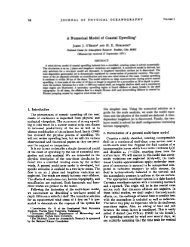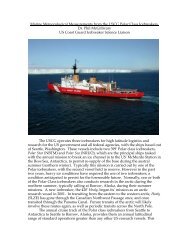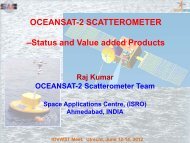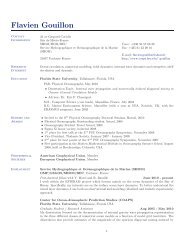Wind Vector Retrievals under Rain with Passive Satellite Microwave ...
Wind Vector Retrievals under Rain with Passive Satellite Microwave ...
Wind Vector Retrievals under Rain with Passive Satellite Microwave ...
Create successful ePaper yourself
Turn your PDF publications into a flip-book with our unique Google optimized e-Paper software.
<strong>Wind</strong> <strong>Vector</strong> <strong>Retrievals</strong> <strong>under</strong> <strong>Rain</strong><br />
<strong>with</strong> <strong>Passive</strong> <strong>Satellite</strong> <strong>Microwave</strong><br />
Radiometers<br />
Thomas Meissner and Frank Wentz<br />
Remote Sensing Systems<br />
Santa Rosa, CA<br />
2008 NASA Ocean <strong>Vector</strong> <strong>Wind</strong> Science<br />
Team Meeting<br />
19 – 21 November 2008<br />
Seattle, WA
Topics<br />
Radiometer HH-<strong>Wind</strong><br />
<strong>Wind</strong> Algorithm<br />
<strong>Wind</strong> Speed <strong>Retrievals</strong> in Hurricanes<br />
Global Radiometer <strong>Wind</strong> Speeds in<br />
<strong>Rain</strong><br />
<strong>Wind</strong> Direction<br />
Comparison: Hurricane <strong>Wind</strong> <strong>Vector</strong>s<br />
Radiometer versus Scatterometer<br />
Sensor Capability<br />
(Surface Emissivity Signals )
Problems to Retrieve <strong>Passive</strong> MW <strong>Wind</strong>s Under <strong>Rain</strong><br />
Possible Mitigations<br />
Attenuation<br />
• Signal/Noise decreases. Especially at higher frequencies.<br />
Use CC-<br />
Band + X- X Band<br />
Lower resolution<br />
<strong>Rain</strong> signal very similar to wind signal<br />
• Algorithm treats increase in rain the same way as increase in wind.<br />
Train algorithm <strong>under</strong> rain.<br />
Try to find channel combinations that are less or not sensitive to rain<br />
but sensitive to wind.<br />
<strong>Wind</strong> speed retrieval algorithm <strong>with</strong>out rain is based on physical<br />
radiative transfer model (RTM).<br />
<strong>Rain</strong> is difficult to model in RTM<br />
• Cloud type<br />
• Beamfilling (rain filling part of retrieval cell)<br />
• Depression in atmospheric temperature (scattering, …)<br />
Use statistical algorithm (measured TBs) rather than physical algorithm<br />
(modeled TBs).
H- <strong>Wind</strong> Algorithm<br />
<strong>Wind</strong> Speed Retrieval in<br />
Tropical Cyclones
Study Data Sets<br />
<strong>Wind</strong> vectors from Surface <strong>Wind</strong> Analysis from from the NOAA’s Hurricane<br />
Research Division ( (HRD HRD)<br />
Collocated <strong>with</strong> <strong>Wind</strong>Sat brightness temperatures<br />
• NRL Level0 data processed by RSS into Level2<br />
• Calibrated<br />
• Optimum interpolated onto 1/8 deg fixed Earth grid (X (X-band band resolution)<br />
17 storms during 2003 and 2004<br />
<strong>Rain</strong> flagged (TB exceeds boundary for rain free ocean scenes)<br />
3 hour time window<br />
Scale HRD winds (1 minute sustained) by 0.88 to compare <strong>with</strong><br />
satellite winds (10 minute sustained)<br />
Resample HRD winds (5 km) onto <strong>Wind</strong>Sat footprint<br />
(30 km for XX-band)<br />
band)<br />
Visual shift of HRD field so that storm center coincides <strong>with</strong> <strong>Wind</strong>Sat<br />
Half of the set is used for training, the other half for testing<br />
About 24,000 wind vector cells for test set<br />
Triple matchup: <strong>Wind</strong>Sat – QuikScat – HRD<br />
• <strong>with</strong>in 3 hours<br />
• 8 storms during 2003 and 2004<br />
• exclude if HRD analysis uses QuikScat<br />
• about 16,000 wind vector cells for testing
Resampling + Scaling of HRD <strong>Wind</strong>s
FABIAN 03 September 2003<br />
HRD<br />
NCEP GDAS<br />
No –<strong>Rain</strong> <strong>Rain</strong> <strong>Wind</strong> Algo <strong>Rain</strong> Rate<br />
Algorithm trained <strong>under</strong> rain free conditions<br />
measures rain rather than wind
2 ( )<br />
2 ( )<br />
T ≈ 1− R τ T<br />
BV V eff<br />
T ≈ 1− R τ T<br />
BH H eff<br />
R: reflectivity<br />
τ: transmittance<br />
λ ⋅T − T<br />
BV BH<br />
R<br />
R<br />
RTM<br />
Polariztion Difference<br />
H λ = 1.5 2.0<br />
→<br />
V<br />
≈<br />
K<br />
τ drops out<br />
insensitive to rain<br />
but insensitive to wind above 8 m/s<br />
Spectral Difference<br />
R ≈ R ≡ R<br />
6H 10H H<br />
( )<br />
T − λ ⋅T ≈ T R τ − λ ⋅ τ<br />
6.8 GHz 10.7 GHz 2 2<br />
BH BH eff H 6.8 GHz 10.7 GHz<br />
insensitive to rain :<br />
∂τ<br />
6.8 GHz<br />
∂ 2 2<br />
1<br />
( τ 6.8 GHz − λ ⋅ τ R<br />
10.7 GHz ) = 0 → λ = ∂ ≈<br />
∂R<br />
∂τ10.7<br />
GHz 3<br />
∂R<br />
keeps sensitivity to<br />
wind
6H – 10H/3 Algo<br />
HRD NCEP GDAS<br />
No –<strong>Rain</strong> <strong>Rain</strong> <strong>Wind</strong> Algo 6H – 10H/3 Algo
Spectral difference between CC-Band<br />
Band<br />
and XX-Band<br />
Band allows to reduce the rain<br />
effect but retains sufficient sensitivity<br />
to wind speed.<br />
Multi Multi-frequency Multi Multi-frequency frequency microwave radiometer<br />
(C. Swift et al.)<br />
six six frequencies at CC-band<br />
band<br />
aircraft aircraft
Training of HH-<strong>Wind</strong><br />
<strong>Wind</strong> Algorithm<br />
∑ ∑<br />
W = α τ + α τ ⋅ SST + β τ ⋅ T + γ τ ⋅T<br />
( ) ( ) ( ) ( ) 2<br />
0 1 i Bi i Bi<br />
i i<br />
Sum over all <strong>Wind</strong>Sat channels<br />
Optimal channel configuration found<br />
by regression<br />
Regression coefficients dependent on<br />
atmospheric transmittance (rain rate)<br />
3 Algorithms<br />
• C-band band ( 6.8 GHz) + higher frequencies<br />
• X-band band (10.7 GHz) + higher frequencies<br />
• K-band band (18.7 GHz) + higher frequencies
HRD<br />
<strong>Rain</strong> Rate NCEP GDAS<br />
C-Band Band Algo X-Band Band Algo K-Band Band Algo
<strong>Wind</strong>Sat HH-<strong>Wind</strong><br />
<strong>Wind</strong> minus HRD <strong>Wind</strong><br />
Degradation of XX-band<br />
band algorithm in higher rain<br />
Degradation of KK-band<br />
band algorithm already in light rain<br />
better than NCEP GDAS<br />
5 m/s standard deviation error in hurricane still useful
Global <strong>Wind</strong> Speed<br />
Algorithm in <strong>Rain</strong><br />
can be applied globally <strong>under</strong><br />
all rain conditions
NCEP wind speeds as ground truth.<br />
Good at low winds, but NCEP is bad and<br />
insufficiently populated at high winds (> 25 m/s).<br />
Hybrid (Statistical<br />
(Statistical-Physical) Physical) Algorithm<br />
Decouples rainy atmosphere (statistical) from<br />
surface (RTM)<br />
<strong>Wind</strong>Sat<br />
TB for V/H pol<br />
Solve RTM for<br />
atmospheric transmittance +<br />
up/downwelling temperatures<br />
Surface<br />
Emissivity<br />
Model<br />
Random wind speed<br />
distribution<br />
between 0 and 50 m/s<br />
Basic<br />
ATM set<br />
Simulated<br />
TB
Performance of Global Algorithm<br />
Ground Truth used for evaluation<br />
NCEP, 1 year, globally<br />
<strong>Wind</strong> speeds below 25 m/s<br />
<strong>Wind</strong>Sat – HRD matchups<br />
High winds<br />
global CC-band<br />
band algorithm on HRD<br />
winds is less accurate than H-<br />
wind algorithm<br />
global C/X C/X-band band algorithms work<br />
well<br />
global KK-band<br />
band algorithm does<br />
NOT work well
<strong>Wind</strong>Sat HH-<strong>Wind</strong><br />
<strong>Wind</strong> versus Global Algorithm<br />
HRD <strong>Rain</strong> Rate<br />
H-<strong>Wind</strong> <strong>Wind</strong> Algo CC-Band<br />
Band Global Algo CC-Band<br />
Band
Radiometer versus<br />
Scatterometer<br />
Triple Matchup Set<br />
<strong>Wind</strong>Sat – QuikSCAT – HRD<br />
<strong>Wind</strong> Speed > 8 m/s<br />
<strong>Wind</strong>Sat HH-<strong>Wind</strong><br />
<strong>Wind</strong> X-band X band Algo
RSS QuikScat (Ku 2001 GMF)<br />
wind speeds biased high<br />
Radiometer wind directions<br />
comparable <strong>with</strong> scatterometer<br />
beside in very high rain<br />
Degradation of radiometer<br />
performance gradual <strong>with</strong><br />
increasing rain rate<br />
Scatterometer performance<br />
varies by storm
<strong>Wind</strong>Sat HH-wind<br />
HH-wind<br />
wind<br />
HRD<br />
FABIAN 04 September 2003<br />
JPL QuikScat<br />
<strong>Rain</strong> Rate
<strong>Wind</strong>Sat HH-wind<br />
HH-wind<br />
wind<br />
HRD<br />
FABIAN 04 September 2003<br />
RSS QuikScat<br />
<strong>Rain</strong> Rate
FRANCES 04 September 2004<br />
<strong>Wind</strong>Sat HH-wind<br />
HH-wind<br />
wind<br />
HRD<br />
JPL QuikScat<br />
<strong>Rain</strong> Rate
FRANCES 04 September 2004<br />
<strong>Wind</strong>Sat HH-wind<br />
HH-wind<br />
wind<br />
HRD<br />
RSS QuikScat<br />
<strong>Rain</strong> Rate
Radiometer <strong>Wind</strong> <strong>Vector</strong>s in <strong>Rain</strong><br />
<strong>Wind</strong> Speed<br />
Hurricanes<br />
Capability Chart<br />
<strong>Wind</strong> Speed<br />
Global <strong>Rain</strong><br />
<strong>Wind</strong> Direction<br />
Hurricanes<br />
SSM/I K no no<br />
SSMIS K no no<br />
TMI X K X no<br />
GMI X K X no<br />
AMSR-E C X K C X no<br />
GCOM C X K C X no<br />
<strong>Wind</strong>Sat C X K C X X<br />
MIS C X K C X X<br />
C X K resolution<br />
wspd > 8 m/s<br />
rain rate < 8 mm/h<br />
wspd > 8 m/s<br />
rain rate < 8 mm/h<br />
3 rd Stokes at X-band
Backup Slides
<strong>Wind</strong> Induced Surface<br />
Emissivity Signal<br />
<strong>Wind</strong>Sat TB over HRD <strong>Wind</strong>s
Above 12 12 m/s wind wind induced emissivity is mainly due to sea foam.<br />
Solid lines: RSS Ocean Emissivity Model that was developed for<br />
wind speeds below 18 m/s linearly extrapolated to high wind<br />
speeds.<br />
Asterisks: Result of <strong>Wind</strong>Sat TB versus HRD wind speed analysis.<br />
No signs of saturation at high winds
18.7 GHz<br />
3rd and 4 th Stokes<br />
7 wind speed bins<br />
between 0 - 40 m/s<br />
solid line:<br />
2 nd order harmonic fit<br />
dashed line:<br />
RSS Ocean Emissivity<br />
Model that was<br />
developed for wind<br />
speeds below 18 m/s<br />
3 rd Stokes:<br />
6K amplitude at<br />
high winds
Radiometer <strong>Wind</strong> Direction<br />
Retrieval in <strong>Rain</strong>
H-<strong>Wind</strong> <strong>Wind</strong> Direction Algorithm<br />
Crucial: Increase of directional signal (3 rd Stokes) of surface<br />
emissivity at high wind versus attenuation by rain<br />
• Strong correlation of high winds and high rain in tropical<br />
cyclones<br />
Maximum Likelihood Estimate (MLE) matches measured TB<br />
to RTM<br />
In rain use only 3 rd and 4 th Stokes but no V/H<br />
• Small V/H signal swamped by atmosphere<br />
<strong>Wind</strong> speed from HH-wind<br />
HH-wind<br />
wind XX-band<br />
XX-band<br />
band algorithm<br />
• MLE only done over wind direction space<br />
• Important to have good wind speed for MLE<br />
• Cannot use no no-rain rain algorithm for retrieving wind speed<br />
Atmospheric transmittance from auxiliary regression<br />
algorithm<br />
SST from Reynolds<br />
Ambiguity selection<br />
• Median Filter<br />
• Nudged <strong>with</strong> NCEP field if wind speed lower than 12 m/s or if<br />
rain rate above 2 mm/h



